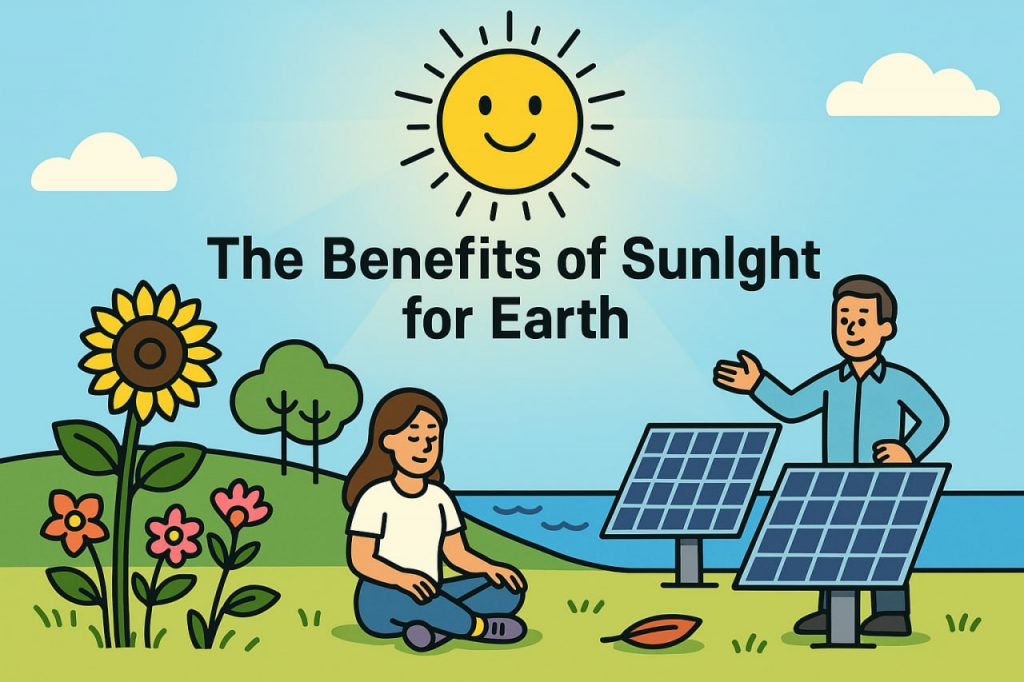Sunlight is the primary source of energy for almost all life on Earth. Through photosynthesis, plants convert sunlight into chemical energy, forming the base of the food chain. Without solar energy, ecosystems as we know them could not exist.
Climate and Temperature Regulation
The Sun provides the heat necessary to keep Earth’s climate stable. Solar radiation warms the atmosphere, land, and oceans, creating the conditions that allow liquid water to exist. The balance between absorbed and reflected sunlight determines global temperatures.
Photosynthesis and Oxygen Production
Plants, algae, and some bacteria use sunlight to carry out photosynthesis, producing not only food but also oxygen. This process has shaped Earth’s atmosphere for billions of years and continues to sustain human and animal life.
Human Health Benefits
Sunlight contributes to human health by stimulating the production of vitamin D, essential for bone strength and immune function. Exposure to natural light also supports mental well-being by regulating circadian rhythms and reducing risks of seasonal depression.
Role in the Water Cycle
Solar energy powers evaporation, the first step in the water cycle. Sunlight heats oceans, lakes, and rivers, causing water to evaporate, form clouds, and eventually return as rain or snow. This cycle replenishes freshwater supplies across the planet.
Renewable Energy Source
Sunlight is a limitless source of renewable energy. Solar panels capture its power to produce electricity without emitting greenhouse gases. This makes sunlight vital in combating climate change and transitioning toward sustainable energy systems.
Conclusion
Sunlight is fundamental to life, climate, ecosystems, and human health. It drives natural cycles, sustains biodiversity, and offers a clean energy future. Protecting Earth’s atmosphere, which regulates solar radiation, ensures that we continue to benefit from this essential gift.
Interesting Facts
Through photosynthesis, plants convert solar energy into chemical energy, forming the foundation of all food chains. Sunlight also regulates the climate, powering weather systems, ocean currents, and the water cycle that sustains ecosystems. Interestingly, about 30% of incoming solar radiation is reflected back into space, while the rest warms the atmosphere, land, and oceans — maintaining the delicate energy balance that makes Earth habitable. For humans, moderate exposure to sunlight stimulates the production of vitamin D, essential for healthy bones and immune function. Seasonal sunlight patterns also influence mood and biological rhythms through the body’s circadian system. On a planetary scale, solar energy drives renewable technologies such as solar panels and photovoltaics, offering a sustainable alternative to fossil fuels. Without the Sun’s steady output, Earth would be a frozen, lifeless world — a reminder that sunlight is both our planet’s engine of life and its ultimate source of stability.
Glossary
- Sunlight – electromagnetic radiation emitted by the Sun.
- Photosynthesis – process by which plants convert sunlight into energy.
- Vitamin D – nutrient produced in skin under sunlight, essential for health.
- Water cycle – continuous movement of water powered by solar energy.
- Renewable energy – energy from sources that do not deplete, like the Sun.
- Circadian rhythms – natural body cycles influenced by light and darkness.


